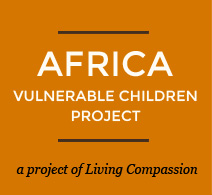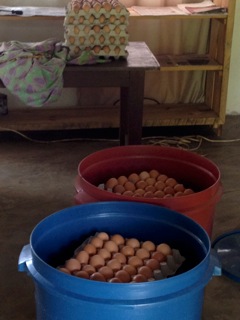
The eggs beat us out to Kantolomba this morning. They are served hard-boiled with nshima each Tuesday and are a big treat. That’s a LOT of eggs!
When we arrived, meal-time was in full swing for the children.
These photographs capture something of the daily miracle of life at the Living Compassion property: children with full tummies carrying leftover food home to share.

Sunlight through the infinite greens of the rainy season paints the whole of Zambia.

Cuties indeed!

Even the teachers cannot tell us whether this is Enoc or Dave. We marvel at the number of sets of twins.
The grown-ups gathered to continue the critical focus on adult English. We talked yesterday about how for each grown-ups to work on their own English is the greatest gift they can offer the young people they are working with, both to model what it is like to keep working on English, and in the sense that the stronger their English is, the stronger the support they can offer the students in their learning.
Our goal for the morning was to write on a poster, where we could see them, all of the resources and tools we have for working on English, and then to choose three to prioritize. We had a fascinating discussion about what “resources and tools” are. We saw that a resource—a book, for example—is something that needs our participation to bring to life. A resource needs us to activate it in order for it to be an effective tool.
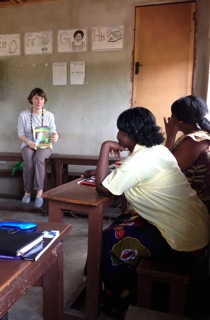
Anna and the Kantolomba English team turning a resource into a tool!
We saw that our most valuable resource is each other. The team came up with lots of different ways we can work with each other to support everyone’s English. The Kantolomba Team can ask each other questions about material they are preparing for their English classes, they can encourage or require one another to speak in English, and we can continue to work on using the weekly email communication between the Kantolomba Team and the US team to support the whole team’s English.
Working together on finding our way around the resource of our new English books, we came to a section in the book called “Explore.” We talked about what the word “explore” means, what exploring is and what an explor-er is. Charles poetically nailed it: “an explorer is a person on a voyage of discovery.”
Being on a voyage of discovery, being explorers, captures perfectly where the whole project is at the moment. The students went on a voyage of discovery to Masala Clinic on Friday and jumped with both feet into being explorers, asking questions, eager to find out more. The teachers are on a voyage of discovery of how to deepen their English. All of us grown-ups are on a voyage of discovery as we build the Living English program. The US team is on a voyage of discovery as we deepen our understanding of the realities of daily life in Kantolomba and how that informs the form the projects take.
Enrolling students is a great example of discovery. We have seen a great deal, the most sobering by far is the lack of support for girls to stay in school. We see a sharp drop-off in the number of girls attending the extra lessons after about grade 5. We have started talking to the team to see about encouraging any girls in that older age range to join us. We shall see….
Some beautiful portraits taken while enrolling in the Living English program:

Mupeta
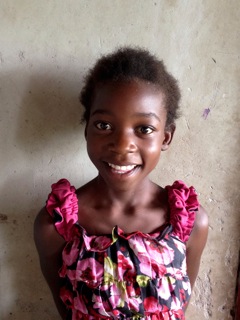
Angela
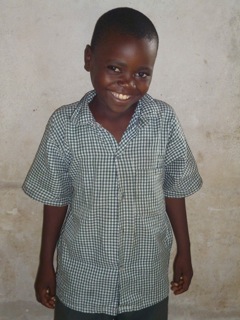
Elijah

Sydney
The afternoon began with a very fun experience of communication and commitment in action. The Grade 8 students had told us what time they would finish school that afternoon. We told them the English class would be held whenever they got back from school. They showed up straight after school, ready to go. They understood—and they did it!
We worked together writing reports of our trip to Masala Clinic—a great workout in the past tense, all in Living English—with the students themselves starring in the report, “We went to Masala Clinic.” “Twaibu asked the doctor a question.” “The doctor answered.” Stay tuned to hear how our report writing project progresses over the coming days!

Twaibu, Peter and Osric work on their reports.
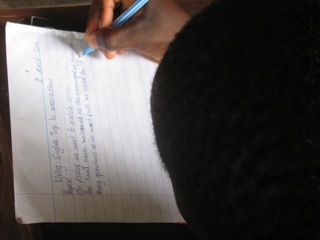
Writing in action
Meanwhile, in the next classroom over, Veronica and Jen were explaining the new program to the Grades 2 and 3 students. We had a great idea drop in —a role play in which a brave volunteer, Agness (first in the individual portraits below), came up and pretended to be 20 years old. In the first scenario, we said she had finished her education through grade 12 and gone on to college to be trained and now had a good job and earned a good wage. In the second scenario, she had dropped out of school in grade 5. After catching on to our game, the children were able to answer questions about her life in the two scenarios. In scenario one, when she was hungry it was “No problem. She can buy a bag of mealie meal.” In scenario two, “She would struggle to survive.” It was a tangible way for the teachers to explain that the Living English program is created for them (the students), and they get to choose if they want to participate. It is designed to help students stay in school and have opportunity. It seemed to be a good time for all and, we hope, helped get the message across.

Veronica with grades 2 and 3

Talking to four girls who came in late and missed the first part of the presentation. Do you remember Naomi, far left? We were very taken with her on our trip in the summer of 2012. She was one of the first in Joy’s pilot English immersion preschool. This last August we were sad to learn she had moved to Lusaka. Imagine our delight when she reappeared!
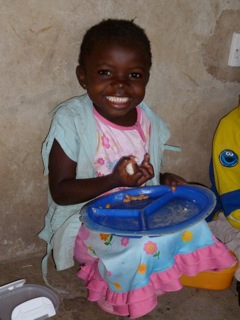
Naomi in 2012. That smile!
Some more enrollment portraits.

Agness

Bridget
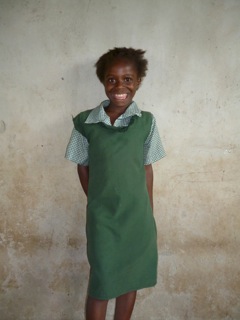
Felistus (Charles’ daughter)
The end of class was the end of the school day. But, as we discovered, the English learning wasn’t over for the day. We met Joy, who showed us her notebook. She had been working independently on exercises from the new book. Wow. At lunchtime, she had told us how much she wants to “train” in English when she’s on her own at home. We talked about how the book could be a great resource for this training and looked together at ways she could work with it on her own. In the course of one afternoon Joy showed us what’s possible when all of that eagerness to train encounters a resource to assist it!

Joy and her new resource
Ethel, standing next to us, looked over at Joy’s work. She commented that she’d like to try some of the exercises on her own, too. It’s contagious! Like Sangha, the more we are surrounded by people who are doing what our heart wants to do, the more we find the willingness to do it. Yea!

Everything well cared for: the cooks’ chitenge uniforms from today freshly washed and hanging in the sun to dry, resting up for another day. We shall follow suit, pun intended.
